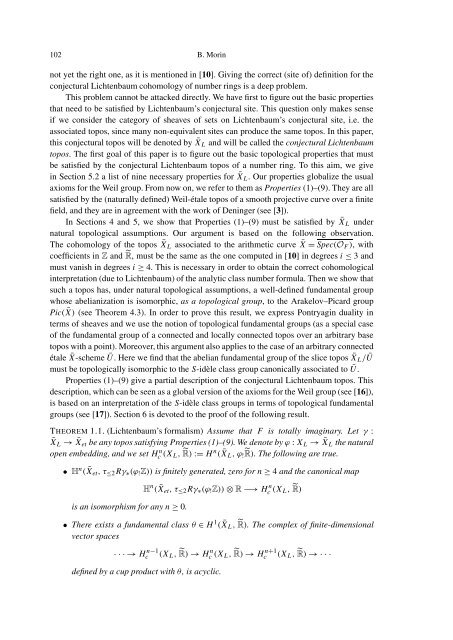THE WEIL-´ETALE FUNDAMENTAL GROUP OF A NUMBER FIELD I
THE WEIL-´ETALE FUNDAMENTAL GROUP OF A NUMBER FIELD I
THE WEIL-´ETALE FUNDAMENTAL GROUP OF A NUMBER FIELD I
You also want an ePaper? Increase the reach of your titles
YUMPU automatically turns print PDFs into web optimized ePapers that Google loves.
102 B. Morin<br />
not yet the right one, as it is mentioned in [10]. Giving the correct (site of) definition for the<br />
conjectural Lichtenbaum cohomology of number rings is a deep problem.<br />
This problem cannot be attacked directly. We have first to figure out the basic properties<br />
that need to be satisfied by Lichtenbaum’s conjectural site. This question only makes sense<br />
if we consider the category of sheaves of sets on Lichtenbaum’s conjectural site, i.e. the<br />
associated topos, since many non-equivalent sites can produce the same topos. In this paper,<br />
this conjectural topos will be denoted by ¯X L and will be called the conjectural Lichtenbaum<br />
topos. The first goal of this paper is to figure out the basic topological properties that must<br />
be satisfied by the conjectural Lichtenbaum topos of a number ring. To this aim, we give<br />
in Section 5.2 a list of nine necessary properties for ¯X L . Our properties globalize the usual<br />
axioms for the Weil group. From now on, we refer to them as Properties (1)–(9). They are all<br />
satisfied by the (naturally defined) Weil-étale topos of a smooth projective curve over a finite<br />
field, and they are in agreement with the work of Deninger (see [3]).<br />
In Sections 4 and 5, we show that Properties (1)–(9) must be satisfied by ¯X L under<br />
natural topological assumptions. Our argument is based on the following observation.<br />
The cohomology of the topos ¯X L associated to the arithmetic curve ¯X = Spec(O F ), with<br />
coefficients in Z and ˜R, must be the same as the one computed in [10] in degrees i ≤ 3and<br />
must vanish in degrees i ≥ 4. This is necessary in order to obtain the correct cohomological<br />
interpretation (due to Lichtenbaum) of the analytic class number formula. Then we show that<br />
such a topos has, under natural topological assumptions, a well-defined fundamental group<br />
whose abelianization is isomorphic, as a topological group, to the Arakelov–Picard group<br />
Pic( ¯X) (see Theorem 4.3). In order to prove this result, we express Pontryagin duality in<br />
terms of sheaves and we use the notion of topological fundamental groups (as a special case<br />
of the fundamental group of a connected and locally connected topos over an arbitrary base<br />
topos with a point). Moreover, this argument also applies to the case of an arbitrary connected<br />
étale ¯X-scheme Ū. Here we find that the abelian fundamental group of the slice topos ¯X L /Ū<br />
must be topologically isomorphic to the S-idèle class group canonically associated to Ū.<br />
Properties (1)–(9) give a partial description of the conjectural Lichtenbaum topos. This<br />
description, which can be seen as a global version of the axioms for the Weil group (see [16]),<br />
is based on an interpretation of the S-idèle class groups in terms of topological fundamental<br />
groups (see [17]). Section 6 is devoted to the proof of the following result.<br />
<strong>THE</strong>OREM 1.1. (Lichtenbaum’s formalism) Assume that F is totally imaginary. Let γ :<br />
¯X L → ¯X et be any topos satisfying Properties (1)–(9). We denote by ϕ : X L → ¯X L the natural<br />
open embedding, and we set H n c (X L, ˜R) := H n ( ¯X L ,ϕ !˜R). The following are true.<br />
• H n ( ¯X et ,τ ≤2 Rγ ∗ (ϕ ! Z)) is finitely generated, zero for n ≥ 4 and the canonical map<br />
is an isomorphism for any n ≥ 0.<br />
H n ( ¯X et ,τ ≤2 Rγ ∗ (ϕ ! Z)) ⊗ R −→ H n c (X L, ˜R)<br />
• There exists a fundamental class θ ∈ H 1 ( ¯X L , ˜R). The complex of finite-dimensional<br />
vector spaces<br />
···→Hc n−1 (X L , ˜R) → Hc n (X L, ˜R) → Hc<br />
n+1 (X L , ˜R) →···<br />
defined by a cup product with θ, is acyclic.

















